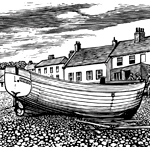Visionary landscapes: Reynolds Stone
An exhibition charting the work of the much-loved engraver Reynolds Stone


Some 35 years ago or so, a schoolboy wrote to ask Reynolds Stone if he would engrave him a bookplate. When the artist, whose centenary falls this year, replied with his modest scale of charges, the pro-spective patron, James Stourton, now chairman of Sotheby’s UK, apologised that he would have to wait until funds were available. A month later, a boxwood block, containing the name, with flourished first and last letters, framed in a Mannerist cartouche, arrived. With it was another letter, explaining that he hated turning down a schoolboy and would accept whatever he could afford, provided the work was satisfactory. Some fundraising manoeuvres reminiscent of Richmal Crompton’s ‘William’ stories followed and honour was satisfied.
Stone gave the impression of living in a parallel and more charitable universe, whose broad skies and secretive landscapes can be seen in his pictorial engravings made for novels, short stories and poems. His most famous but seldom attributed work is the Royal Arms used on the British passport, which he engraved in 1956. He developed an individual style of lettering onto wood blocks, with white calligraphic strokes on a dark ground, or, when occasion demanded, stately Roman capitals. These were also carved on stone, and included the memorial to Sir Winston Churchill in Westminster Abbey. He was an artist-craftsman with the range of Eric Gill (with whom he briefly studied), but a completely different personality, reticently poised, but lyrical.
One of the last headstones designed by Stone was for Ben-jamin Britten in 1976, who pre-deceased him by three years. They met at the christening of Susannah Piper, daughter of the artist John Piper, and a lasting friendship developed between the households, based on a shared love of English romantic art, which forms the basis for an exhibition at Aldeburgh this month.
The Stones attended Britten’s concerts and operas whenever they could, and were in Venice with the Pipers for the premiere of The Turn of the Screw in 1954; Stone held his first exhibition of watercolours at the Aldeburgh Festival in 1958. The musical couple often stayed at the Old Rectory, Litton Cheney in west Dorset, the Stones’ modest late-Georgian house with its secret garden of pools and overgrown greenery, recently seen fronting the advertisement pages of COUNTRY LIFE. Photographs by Janet Stone, who lured a wide cross-section of the mid-century English intelligentsia to Dorset, show how they exchanged the pebbles of Aldeburgh beach for those of Chesil Bank.
There were engravings for Britten’s music scores, and for The Other Side of the Alde, a reminiscence by the art historian Kenneth Clark of his childhood at Sudbourne Hall, originally written for a Britten 50th-birthday Festschrift and reprinted this year. There will be publications and further Stone centenary exhibitions during the course of the year, for which more information can be found on the website www.reynoldsstone.co.uk.
‘Visionary Landscapes: Rey-nolds Stone, a centenary exhibition’ is at the Britten-Pears Foundation, The Red House, Aldeburgh, Suffolk, from April 14–24, open daily except Sundays, 2pm–5pm (01728 451700; www.brittenpears.org)
Sign up for the Country Life Newsletter
Exquisite houses, the beauty of Nature, and how to get the most from your life, straight to your inbox.
Country Life is unlike any other magazine: the only glossy weekly on the newsstand and the only magazine that has been guest-edited by HRH The King not once, but twice. It is a celebration of modern rural life and all its diverse joys and pleasures — that was first published in Queen Victoria's Diamond Jubilee year. Our eclectic mixture of witty and informative content — from the most up-to-date property news and commentary and a coveted glimpse inside some of the UK's best houses and gardens, to gardening, the arts and interior design, written by experts in their field — still cannot be found in print or online, anywhere else.

